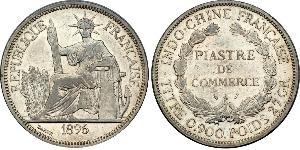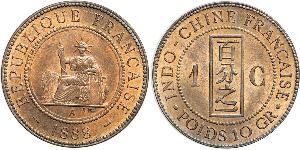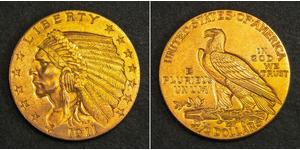1 Piastre
1922, French Indo-China. Large Silver Piastre (Trade Dollar) Coin. NGC MS-62! Mint Year: 1922 Reference: KM-5a.3. R! Denomination: Piastre (Trade Coin) Min Place: Heaton´s mint (Birmingham, UK) Condition: Certified and graded by NGC as MS-62! Material: Silver (.900) Diameter: 39mm Weight: 27gm Obverse: Seated liberty, holding fasces, leaning on rudder and anchor (symbols industry & trade). Legend: REPUBLIQUE FRANCAISE Exergeu: 1922 (BARRE) Reverse: Denomination "PIASTRE DE COMMERCE" in three lines, mint initial (H) below. All within wreath. Legend: INDO-CHINE FRANCAISE * TITRE 0,900 . POIDS 27 GR. * The piastre de commerce was the currency of French Indochina between 1885 and 1952. It was subdivided into 100 cent, each of 5 sapeque. Prior to the arrival of the French in Indo-China in the second half of the 19th century, cash coins similar to those used in the provinces of China circulated in the area that is nowadays known as Vietnam. There was also a silver milled dragon coin and associated subsidiary coinage in circulation. The dragon coin is believed to have been in imitation of the Spanish and Mexican silver dollars which also circulated widely in the region at that time, however the dragon dollars were worth less because the fineness of the silver was less than that in the Spanish and Mexican dollars. In the region that is nowadays Cambodia and Laos, the Siamese coinage circulated and Cambodia had its own regional varieties of the Siamese Tical (Thai Baht). The French began their Indo-Chinese empire in 1862 with Cochin-China which is the area around the Mekong delta and Saigon, and which is nowadays the extreme southern part of Vietnam. This empire very quickly expanded to include Cambodia which had been a vassal state of the Kingdom of Siam. In 1875, the French introduced a Cambodian franc to Cambodia. Although these francs were minted in Belgium between 1875 and 1885, they always bore the date 1860. The French also began to introduce a subsidiary coinage in 'cents' into Cochin-China in the late 1870s. These cents were actually subsidiary coinage of the Mexican dollar unit as opposed to being subsidiary coinage of the French franc. In 1884, the French Indo-Chinese empire further expanded to incorporate Annam and Tonkin-China. The following year, in 1885, the French introduced a new silver Piastre de commerce and associated subsidiary coinage throughout the entire Indo-Chinese colonies in order to increase monetary stability. The piastre was initially equivalent to the Mexican peso. The piastre was therefore a direct lineal descendent of the Spanish pieces of eight that had been brought to the orient from Mexico on the Manila Galleons. It was initially on a silver standard of 1 piastre = 24.4935 grams pure silver. This was reduced to 24.3 grams in 1895. French Indo-China was one of the last places to abandon the silver standard. The piastre remained on the silver standard until 1920, when due to the rise in the price of silver after the First World War, it was pegged to the French franc at a varying rate hence putting it unto a gold exchange standard. The silver standard was restored in 1921 and maintained until 1930, when the piastre was pegged to the franc at a rate of 1 piastre = 10 francs. During the World War II Japanese occupation, an exchange rate of 0.976 piastre = 1 Japanese yen operated, with the pre-war peg to the franc restored after the war. However, in December 1945, to avoid the French francs devaluation, the peg was changed to 1 piastre = 17 francs. em>. Bid with Confidence! French Indochina (French: Indochine française; Vietnamese: Ðông Duong thu?c Pháp, frequently abbreviated to Ðông Pháp) was the part of the French colonial empire in Indochina in southeast Asia. A federation of the three Vietnamese regions, Tonkin, Annam, and Cochinchina, as well as Cambodia, was formed in 1887. Laos was added in 1893. The capital was moved from Saigon to Hanoi in 1902. During World War II, the colony was administered by Vichy France and was under Japanese occupation. Beginning in 1945, Ho Chi Minh led a communist revolt against French rule known as the French Indochina War. In the South, an anti-Communist government led by former Emperor Bao Dai was granted independence in 1949. Following the Geneva Accord of 1954, Ho's group became the government of North Vietnam, although the Bao Dai government continued to rule in the South. The colonial administration of Annam, or Central Vietnam, was dissolved in 1955 and region was split between North and South, as provided for in the Geneva Accord.
más ...

|
Publicado por:
anonymous 2015-06-23 |
|
||
|
||
|
||
|
||
Descripción:
 Deutsch
Deutsch
 Русский
Русский
 Українська
Українська
 English
English
 Italiano
L'Indochine française (français : Indochine française ; vietnamien : Ðông Duong thuếc Pháp, fréquemment abrégé en Ðông Pháp) faisait partie de l'empire colonial français en Indochine en Asie du Sud-Est. Une fédération des trois régions vietnamiennes, Tonkin, Annam et Cochinchine, ainsi que le Cambodge, fut créée en 1887. Le Laos fut ajouté en 1893. La capitale fut déplacée de Saigon à Hanoï en 1902. Pendant la Seconde Guerre mondiale, la colonie fut administrée par Vichy France et était sous occupation japonaise. À partir de 1945, Hô Chi Minh a mené une révolte communiste contre la domination française connue sous le nom de guerre d'Indochine française. Dans le Sud, un gouvernement anticommuniste dirigé par l'ancien empereur Bao Dai a obtenu l'indépendance en 1949. À la suite de l'Accord de Genève de 1954, le groupe de Ho est devenu le gouvernement du Nord-Vietnam, bien que le gouvernement Bao Dai ait continué à régner dans le Sud. L'administration coloniale de l'Annam, ou Centre du Vietnam, a été dissoute en 1955 et la région a été divisée entre le Nord et le Sud, comme le prévoit l'Accord de Genève.">
Italiano
L'Indochine française (français : Indochine française ; vietnamien : Ðông Duong thuếc Pháp, fréquemment abrégé en Ðông Pháp) faisait partie de l'empire colonial français en Indochine en Asie du Sud-Est. Une fédération des trois régions vietnamiennes, Tonkin, Annam et Cochinchine, ainsi que le Cambodge, fut créée en 1887. Le Laos fut ajouté en 1893. La capitale fut déplacée de Saigon à Hanoï en 1902. Pendant la Seconde Guerre mondiale, la colonie fut administrée par Vichy France et était sous occupation japonaise. À partir de 1945, Hô Chi Minh a mené une révolte communiste contre la domination française connue sous le nom de guerre d'Indochine française. Dans le Sud, un gouvernement anticommuniste dirigé par l'ancien empereur Bao Dai a obtenu l'indépendance en 1949. À la suite de l'Accord de Genève de 1954, le groupe de Ho est devenu le gouvernement du Nord-Vietnam, bien que le gouvernement Bao Dai ait continué à régner dans le Sud. L'administration coloniale de l'Annam, ou Centre du Vietnam, a été dissoute en 1955 et la région a été divisée entre le Nord et le Sud, comme le prévoit l'Accord de Genève."> Français
Français
 Español
Español
 汉语
汉语
 Deutsch
Deutsch
 Русский
Русский
 Українська
Українська
 English
English
 Italiano
L'Indochine française (français : Indochine française ; vietnamien : Ðông Duong thuếc Pháp, fréquemment abrégé en Ðông Pháp) faisait partie de l'empire colonial français en Indochine en Asie du Sud-Est. Une fédération des trois régions vietnamiennes, Tonkin, Annam et Cochinchine, ainsi que le Cambodge, fut créée en 1887. Le Laos fut ajouté en 1893. La capitale fut déplacée de Saigon à Hanoï en 1902. Pendant la Seconde Guerre mondiale, la colonie fut administrée par Vichy France et était sous occupation japonaise. À partir de 1945, Hô Chi Minh a mené une révolte communiste contre la domination française connue sous le nom de guerre d'Indochine française. Dans le Sud, un gouvernement anticommuniste dirigé par l'ancien empereur Bao Dai a obtenu l'indépendance en 1949. À la suite de l'Accord de Genève de 1954, le groupe de Ho est devenu le gouvernement du Nord-Vietnam, bien que le gouvernement Bao Dai ait continué à régner dans le Sud. L'administration coloniale de l'Annam, ou Centre du Vietnam, a été dissoute en 1955 et la région a été divisée entre le Nord et le Sud, comme le prévoit l'Accord de Genève.">
Italiano
L'Indochine française (français : Indochine française ; vietnamien : Ðông Duong thuếc Pháp, fréquemment abrégé en Ðông Pháp) faisait partie de l'empire colonial français en Indochine en Asie du Sud-Est. Une fédération des trois régions vietnamiennes, Tonkin, Annam et Cochinchine, ainsi que le Cambodge, fut créée en 1887. Le Laos fut ajouté en 1893. La capitale fut déplacée de Saigon à Hanoï en 1902. Pendant la Seconde Guerre mondiale, la colonie fut administrée par Vichy France et était sous occupation japonaise. À partir de 1945, Hô Chi Minh a mené une révolte communiste contre la domination française connue sous le nom de guerre d'Indochine française. Dans le Sud, un gouvernement anticommuniste dirigé par l'ancien empereur Bao Dai a obtenu l'indépendance en 1949. À la suite de l'Accord de Genève de 1954, le groupe de Ho est devenu le gouvernement du Nord-Vietnam, bien que le gouvernement Bao Dai ait continué à régner dans le Sud. L'administration coloniale de l'Annam, ou Centre du Vietnam, a été dissoute en 1955 et la région a été divisée entre le Nord et le Sud, comme le prévoit l'Accord de Genève."> Français
Français
 Español
Español
 汉语
汉语
Variaciones de moneda:
318 pieza(s)
Precio:
297 pieza(s)
Usted podría estar interesado en las siguientes monedas
2025-05-09
- New coin is added to 2.5 Dólar Estados Unidos de América (1776 - ) Oro
2.5 Dólar Estados Unidos de América (1776 - ) Oro
grupo tiene 259 monedas / 244 precios
⇑
1911, United States. Gold "Indian Head" Quarter Eagle ($2.50) Coin. 4.19gm!
Mint Year: 1911 Reference: KM-129. Designer: Bela Lyon Mint Place Philadelphia Type: Indian Head Gold Quar ...
2025-05-07
- Mejoras en el catálogo de monedas en línea / agrupamiento de monedas
150 coins were grouped from 2025-04-30 to 2025-05-07
Una de ellas es:
1 Florin Reino Unido de Gran Bretaña e I ...
grupo tiene 50 monedas / 44 precios
⇑
BRITISH COINS, Victoria, ‘Godless’ Florin, 1849, crowned gothic bust left, WW behind, rev crown ...
Usted podría estar interesado en …

-600-300-PRgKbzbiy6cAAAFOuNTnFiKf.jpg)

-300-150-3uEKbzbiqLQAAAFLenijltwf.jpg)







-300-150-FC3BwcI034cAAAEoFIp8PEi0.jpg)

-300-150-NFEKbzbi_VgAAAFLIcbk0KjK.jpg)
-300-150-UcUKX9IS93YAAAFbhmyt4uEz.jpg)





